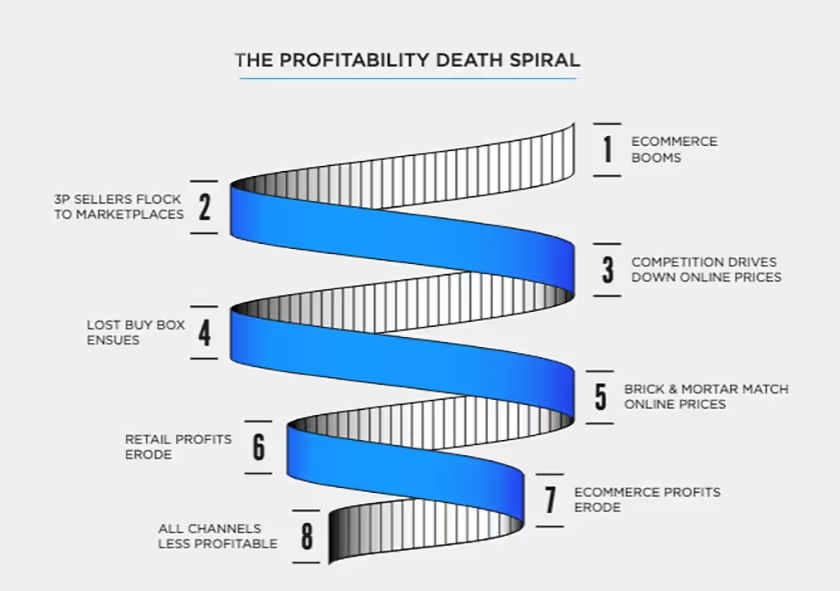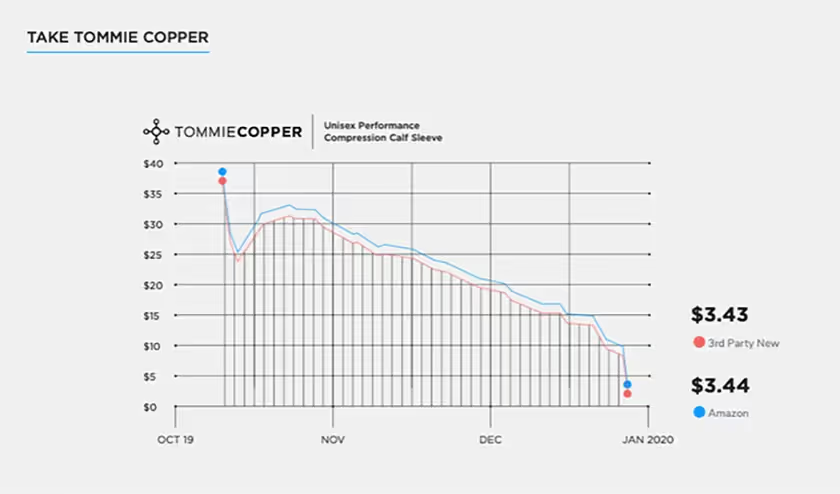Webinar Recap: Measuring the Financial Impact of Marketplace Control
Maintaining control of your brand on marketplaces is critical for your long-term growth. But what is the financial impact of marketplace control, and why should brand leaders care?
Maintaining control of your brand on marketplaces is critical for your long-term growth. To maximize your brand’s health and profit, you need to regain control as quickly as possible. But what is the actual impact of marketplace control, and why should brand leaders care? In this week’s Pattern webinar, we’re talking about what marketplace control is, why it’s so critical for your brand, and the financial impact it can ultimately have on your business.
What is marketplace control?
Having marketplace control means that your brand is being represented with integrity online, your product is being distributed via authorized sellers, and that product is being sold at authorized price points. Essentially, your ecommerce is a well-oiled machine across all channels. Maintaining overall marketplace control requires control in three primary areas:
- Pricing: price control is retained by enforcing a MAP policy, creating price parity across all channels, and adhering to national promos.
- Branding: brand control is retained by ensuring the quality of your product images is consistent across channels, your copy is compliant, and your messaging is unified.
- Distribution: distribution control is retained by only distributing through authorized sellers, meeting customer expectations for product quality, and aligning channel incentives.
Why does marketplace control matter?
Marketplace control matters because without it, every channel of your business suffers, including, and perhaps especially, your brick and mortar distributors. Before the advent of marketplace ecommerce, brands were highly incentivized to use scaled distribution to get their product into as many hands as possible. With scarce ways to compare prices offline, scaled distribution worked really well.
Marketplace ecommerce has completely flipped the script. Marketplace ecommerce makes price matching instantaneous, because customers can see the price of a product from almost every single distributor who’s selling it, at the same time. That much access makes wide distribution a liability. “Because there is so much transparency in the world today across retail environments, your success is really predicated on the degree to which you have very limited distribution and what we call selective distribution on your online channels,” said John LeBaron, Pattern’s Chief Revenue Officer.
Without pricing control, branding control, and distribution control, you open the door wide for unauthorized sellers to erode your pricing and harm your brand reputation by representing it poorly online. Without control, an unauthorized seller can get their hands on your product, list it on Amazon for however much they want, and then markdown the price to get ahead on marketplaces and undercut authorized sellers, forcing other sellers to lower their prices in order to compete.
Without control, these prices will continue to be lowered, and it will penalize your distributors who are trying to follow the rules. Pretty soon, your authorized sellers may drop your product altogether because—due to eroded prices online—they cannot afford the overhead to carry it, sell it, and price match. These negative impacts are cyclical, particularly for your brick and mortar distributors. Without control, your brand will be caught in a Profitability Death Spiral where you’ll consistently lose the Buy Box online—disincentivizing distributors from creating engaging and clean listings and fragmenting your ad strategy—and you’ll lose distributors who can’t afford to carry your product.
You’ll also watch your brand lose its value across all channels. According to LeBaron, the race to wholesale eats at your brand equity. With too-low prices, customers perceive your products as lower value. Lack of control on the distribution and branding fronts means that unauthorized sellers can easily misrepresent your brand in their listings and their interactions with customers, diminishing your equity further. According to LeBaron, if brand equity is falling in one channel, it’s “certainly falling in other channels as well.”
The financial impact of no marketplace control
“Once you’re in that death spiral, it’s hard to turn it back around. You have to make certain changes to really recover from that,” said Jason Beesley, Pattern’s CFO.

Tommie Copper is one example of a brand that didn’t address marketplace control immediately and were eventually significantly harmed by price erosion. Without control, Tommie Copper watched the pricing on their products plummet at the hands of unauthorized sellers, taking their margins with them.

Tommie Copper is just one example. LeBaron shared another example of a brand that sought out Pattern’s help to regain control of their business after price matching gutted their profits. “We had a large retail consumer electronics brand that came to us, and they were paying Best Buy half a million dollars a month in price match guarantees just because they had 400 unauthorized sellers selling all of their products on Amazon, and they were just hemorrhaging profitability,” LeBaron said. This brand didn’t know who the unauthorized sellers were, why they were dropping the price, or where they got the product because they lacked proper control.
“Not only does that price match guarantee really start to hurt,” added Scott Crandall, Pattern’s Head of Revenue Operations, “but you just lose credibility. You lose any leverage that you have with those retailers. They don’t want to have to deal with all of that, so they’re going to give shelf space to other people at some point who have that better price stability online.”
For some brands, having more control doesn’t necessarily provide significant gains, but it does act as a protective barrier helping your brand avoid scenarios like these later down the road. “In some cases, getting control on ecommerce, even if it’s a net not loss or not gain from a pricing and margin perspective, is generally protecting or hopefully helping to reinvent and improve and turn around the profitability death spiral that’s happening in brick and mortar, which ultimately might be 80% or 70% of your sales, maybe higher than that,” LeBaron said.
The benefits of marketplace control
The equation for success in ecommerce is:

You need customers to see your listings in the right way at the right time, you need for them to be engaged enough to click, and you need pricing that is attractive and reasonable. Marketplace control, particularly distribution control, helps you maximize every element of the ecommerce equation, because single sellers have far more incentives to be the ones driving the traffic and the conversion and positively shaping your brand image online than a wide network of sellers.
“The issue in ecommerce isn’t getting to the end consumer. The marketplaces handle that wonderfully,” said Beesley. “The issue is more how you are doing that, and that’s why limiting your distribution really allows you to even further maximize that reach.” Control on marketplaces protects your business and it speeds up profitability. “As you have that selective distribution on Amazon, on these marketplaces, there’s really a great flywheel that starts to develop there, a really virtuous cycle,” Crandall said.
Your distributors are more invested in your brand’s image and success. They provide quality listings with dynamic copy. They focus on a better customer experience, and you have a more consistent, sharpened ad strategy that gives you higher rankings. Soon, instead of losing profits, you’re making long-term gains and really solidifying your brand presence.
To learn more about marketplace control, how Pattern can help you win on your ad strategy to further your brand’s growth, and what opportunities for growth are available to your brand, reach out to the Pattern team.


.jpg)





.jpg)

